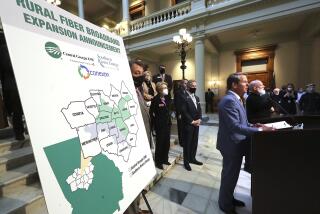Promising Path to a New Net
- Share via
Vice President Al Gore unveiled national plans Tuesday to build a new Internet with speeds that boggle the mind of today’s Net user. On Internet 2, it will be possible to transmit the entire Encyclopaedia Britannica in under a second and the entire Library of Congress in under a minute. The hitch is that Internet 2’s lightning-fast connections will not be available to the private sector until government and academic institutions have been hooked up. That could take five years.
On the bright side, Internet 2 is a model of how nonprofit universities and for-profit companies can work together to their mutual advantage. High-technology companies made the Internet 2 deal possible by donating more than $500 million in equipment. In return, the companies will get to use the new Net as a laboratory to test which high technologies generate the greatest popular demand. That’s a good idea, since in the past decade cable and telephone companies have misspent hundreds of millions of dollars creating technologies, like “video on demand,” that were promoted by their engineers but rejected by the public.
One of Internet 2’s key uses will be providing “virtual laboratories” in which academics on different continents can share data in the kind of visually rich environments that stimulate new discovery. And there are practical reasons to open Internet 2 as soon as possible for some private uses--for instance, to give a big-city heart surgeon the virtual reality techniques to help physicians save an infant in a rural clinic.
Yet Congress should be wary of premature privatization, for that would defeat the purpose of Internet 2: to provide an alternative for academics boxed out of their old cyberspace meeting spots by the commercialization of Internet 1.
Support for Internet 2 and a related project--Next Generation Internet--has been mounting in Washington, and Congress is expected to approve more than $100 million for the next fiscal year to set technological standards that will ensure Internet 2’s success.
Congress needs to sharpen its oversight of Internet 2 development, which is managed by no fewer than 11 congressional committees and seven federal agencies. With improved oversight the new Net could pay off as handsomely as did U.S. spending in the 1960s on a Defense Department project called ARPANET, which became the Internet we know today. While imperfect, it has changed the way we communicate, do business and learn. Hardly a bad investment.






